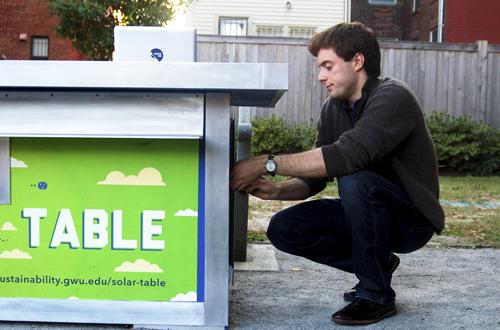
This post was written by Hatchet reporter Gloriana Sojo
Cell phone battery running low? Now, you can charge it outside.
A group of students installed GW’s first solar-powered table in Square 80 this week, with room for up to eight electronic devices.
For the last eight months, sophomore Ben Pryde petitioned GW for about $5,000 to set up the table, which he called a prototype for other potential projects around campus.
After the Center for Student Engagement agreed to fund half the project’s cost, Pryde, who is also a Student Association senator, got the SA and Residence Hall Association to pitch in the remaining $2,500. With a maximum output of 3,500 watts, the table can even power student organization events like outdoor movie screenings and concerts.
He said he and his team of collaborators are eager to gauge the campus reaction to his project and would then decide if he should move forward with more tables at other campus sites.
Pryde said he hopes the table, which also powers internal batteries that keep the table juiced on cloudy days, will show students that solar power is a reliable energy source.
Amit Ronen, the director of GW’s Solar Institute, said the project is an opportunity for the entire community to learn about and discuss solar energy.
“A lot of people haven’t had a chance to see solar panels up close yet,” Ronen said. “This project will provide that experience and show how just a thin layer of semiconducting material covered by just a sheet of glass can produce electricity with no moving parts or emissions.”
While his original plans called for a table with 23 outlets, Pryde said he decided on three times fewer outlets for a more cost-effective project.
With solar panels atop three residence halls, GW already boasts the largest source of on-site solar power in D.C. Solar energy has also been a University priority within its Office of Sustainability.
“This project highlights student innovation, which mirrors the incredible innovation that’s going in the solar space right now,” said Ronen. “The technology is really moving in leaps and bounds with prices decreasing dramatically and people thinking of new ways to use it and this project is a good example of that.”
Pryde, a political science and economics double-major who worked on the table with students from various academic areas, said the project showcases the ability for people in every field to “create things that benefit society as a whole.”
“I think people underestimate themselves sometimes, and their abilities to work outside their comfort zones,” he said. “But even if you are not an engineer, you have skills that can build something like this.”





